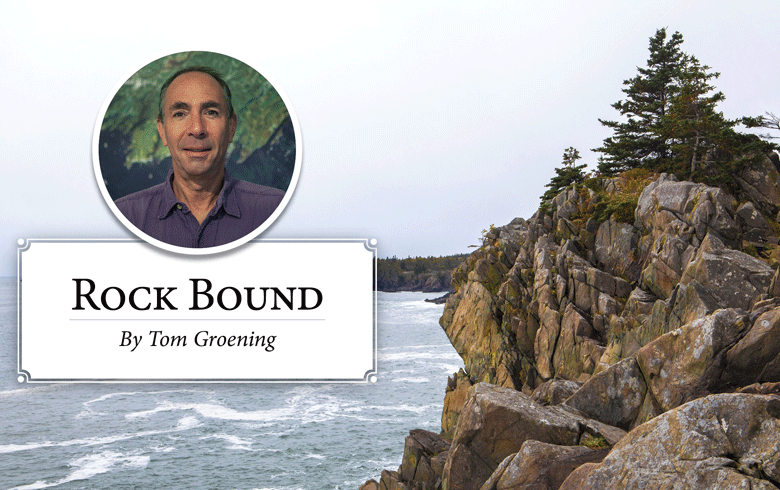This time of year has me thinking about Cape Cod. I know the Cape is mostly a summer vacation destination, but for about 12 years my family spent the April school vacation there, always on the outer Cape.
Let’s face it—Maine doesn’t do spring well. I become a bit dour enduring our mud, rain, and wind. For most of those dozen years, we found spring on the Cape, about three weeks ahead of Maine. We loved to walk the ocean beaches, miles of sand and surf, dunes blocking the civilized world on one side, the endless horizon on the other. Or, as Henry David Thoreau put it, “A man may stand there and put all America behind him.”
Often, we wouldn’t see another human once we got away from the parking area, and we would see migrating whales, spouting a mile or two offshore.
I’ve sustained more than a few sunburns on that April vacation week. We’ve actually jumped in the ocean and swam a bit in the bay when temperatures, a few times anyway, hit the low 80s.
t’s the canary in the coal mine for some of the Maine coast’s challenges. Housing, for one.
But climate change brought a different spring pattern, now often marked by windy weather with temps topping out at 50. Oh, well.
The Cape remains a fascinating place, though. It’s the canary in the coal mine for some of the Maine coast’s challenges. Housing, for one. Health care workers, police officers, teachers, and retail, lodging, and restaurant workers must commute an hour or more from off-Cape to their jobs, because housing is so expensive.
Sea level rise and storm surge are more damaging there, given that the Cape is essentially a sand bar.
The key moment for the Cape was in 1961 when President John Kennedy signed the act creating the national seashore there. He might have been accused of acting in self-interest because of his family’s compound in Hyannis Port, but planning for the designation had been underway for years.
I’ve read newspaper clippings reporting on contentious community meetings about the seashore proposal. Locals predicted young adults would flock to the Cape and camp out in the dunes, leaving litter and worse behind and that tacky T-shirt shops and hot dog stands would proliferate.
Neither played out, but in the part of the Cape that didn’t come under the national seashore, motels, miniature golf, and ice cream shops did sprawl. Some towns wisely implemented strict zoning on Route 6, which travels though the center of the Cape. Eastham, just east of the “elbow” in the flexed arm of the peninsula, removed the zoning on Route 6 and predictable sprawl followed.
And so I marvel at the foresight of preserving those 40 miles of ocean beach and 44,000 acres of land. Houses that predated the designation were allowed to stay, but when those on the dunes collapse down onto the beach—as is inevitable—they cannot be rebuilt.
In preparation for our April visits, I often would read about the Cape. Henry Beston’s The Outermost House (1928) is on par with any nature writing. Beston, recovering from the horrors of what he witnessed in World War I, built himself a small cottage on land his family owned on the beach near the Nauset Inlet and ended up living there for close to two years. (After his death, the blizzard of 1978 took the house, a fate which I believe would have pleased Beston.)
His contemplations are wonderful, observing the patterns that reveal themselves in waves, the habits of shore birds scurrying along the sand, and his visits on winter nights by “coast guardsmen” patrolling the beach, on the lookout for ships foundering on the ever-changing shoals.
A biography of Beston, Orion on the Dunes (2016) by Daniel G. Payne, is well worth reading and includes Beston’s life in Nobleboro, where he wrote Northern Farm (1948).
Thoreau’s Cape Cod (1865) is interesting as a historical travelogue. He takes a train from Lexington, then a horse-drawn coach to Orleans and, with a companion, walks the ocean shore all the way to the Cape’s tip at Provincetown.
He mistakenly predicts the Cape would end at Orleans by 1960, and he indulges in some snarky descriptions of the people he stays with at night.
My Own Cape Cod by Gladys Taber (1971) also has its share of snarkiness, with the fussy older writer taking aim at hippies visiting the area. And Becoming Cape Cod: Creating a Seaside Resort (2002) by James O’Connell provides more history, with its best bits on the late 19th century through the 1930s era, as Americans learned the art of the summer vacation
One more pick: Richard Russo’s novel, That Old Cape Magic (2009).
If money and a job were not issues, I think I would visit the outer Cape for the entire month of September. No bugs, water still warm, most businesses open, but teens and college kids back in school. Maybe I’m becoming snarky.
Tom Groening is editor of The Working Waterfront. He may be reached at tgroening@islandinstitute.org.





